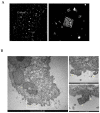Nipah Virus Infection Generates Ordered Structures in Cellulo
- PMID: 35891503
- PMCID: PMC9317923
- DOI: 10.3390/v14071523
Nipah Virus Infection Generates Ordered Structures in Cellulo
Abstract
Nipah virus (NiV) is a zoonotic paramyxovirus with a fatality rate of up to 92% in humans. While several pathogenic mechanisms used by NiV to counteract host immune defense responses have been described, all of the processes that take place in cells during infection are not fully characterized. Here, we describe the formation of ordered intracellular structures during NiV infection. We observed that these structures are formed specifically during NiV infection, but not with other viruses from the same Mononegavirales order (namely Ebola virus) or from other orders such as Bunyavirales (Junín virus). We also determined the kinetics of the appearance of these structures and their cellular localization at the cellular periphery. Finally, we confirmed the presence of these NiV-specific ordered structures using structured illumination microscopy (SIM), as well as their localization by transmission electron microscopy (TEM), scanning electron microscopy (SEM), and correlative light and electron microscopy (CLEM). Herein, we describe a cytopathogenic mechanism that provides a new insight into NiV biology. These newly described ordered structures could provide a target for novel antiviral approaches.
Keywords: CLEM; Nipah virus; SEM; SIM; TEM; in cellulo; ordered structures.
Conflict of interest statement
The authors declare no conflict of interest.
Figures








Similar articles
-
Tetherin Inhibits Nipah Virus but Not Ebola Virus Replication in Fruit Bat Cells.J Virol. 2019 Jan 17;93(3):e01821-18. doi: 10.1128/JVI.01821-18. Print 2019 Feb 1. J Virol. 2019. PMID: 30429347 Free PMC article.
-
Third Helical Domain of the Nipah Virus Fusion Glycoprotein Modulates both Early and Late Steps in the Membrane Fusion Cascade.J Virol. 2020 Sep 15;94(19):e00644-20. doi: 10.1128/JVI.00644-20. Print 2020 Sep 15. J Virol. 2020. PMID: 32669342 Free PMC article.
-
Efficient reverse genetics reveals genetic determinants of budding and fusogenic differences between Nipah and Hendra viruses and enables real-time monitoring of viral spread in small animal models of henipavirus infection.J Virol. 2015 Jan 15;89(2):1242-53. doi: 10.1128/JVI.02583-14. Epub 2014 Nov 12. J Virol. 2015. PMID: 25392218 Free PMC article.
-
Envelope-receptor interactions in Nipah virus pathobiology.Ann N Y Acad Sci. 2007 Apr;1102(1):51-65. doi: 10.1196/annals.1408.004. Ann N Y Acad Sci. 2007. PMID: 17470911 Free PMC article. Review.
-
Recent advances in the understanding of Nipah virus immunopathogenesis and anti-viral approaches.F1000Res. 2019 Oct 16;8:F1000 Faculty Rev-1763. doi: 10.12688/f1000research.19975.1. eCollection 2019. F1000Res. 2019. PMID: 31656582 Free PMC article. Review.
Cited by
-
Host-Pathogen Interactions Influencing Zoonotic Spillover Potential and Transmission in Humans.Viruses. 2023 Feb 22;15(3):599. doi: 10.3390/v15030599. Viruses. 2023. PMID: 36992308 Free PMC article. Review.
-
Henipaviruses: epidemiology, ecology, disease, and the development of vaccines and therapeutics.Clin Microbiol Rev. 2025 Mar 13;38(1):e0012823. doi: 10.1128/cmr.00128-23. Epub 2024 Dec 23. Clin Microbiol Rev. 2025. PMID: 39714175 Free PMC article. Review.
References
MeSH terms
Substances
LinkOut - more resources
Full Text Sources
Medical

